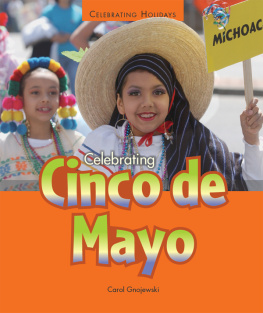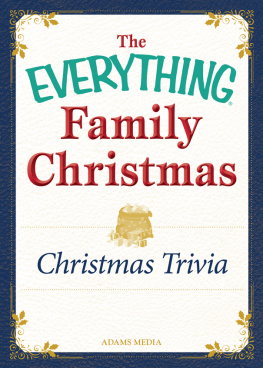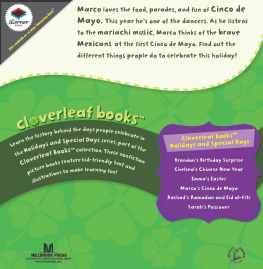Carol Gnojewski - Celebrating Cinco de Mayo
Here you can read online Carol Gnojewski - Celebrating Cinco de Mayo full text of the book (entire story) in english for free. Download pdf and epub, get meaning, cover and reviews about this ebook. year: 2013, publisher: Enslow Publishers, Inc., genre: History. Description of the work, (preface) as well as reviews are available. Best literature library LitArk.com created for fans of good reading and offers a wide selection of genres:
Romance novel
Science fiction
Adventure
Detective
Science
History
Home and family
Prose
Art
Politics
Computer
Non-fiction
Religion
Business
Children
Humor
Choose a favorite category and find really read worthwhile books. Enjoy immersion in the world of imagination, feel the emotions of the characters or learn something new for yourself, make an fascinating discovery.
- Book:Celebrating Cinco de Mayo
- Author:
- Publisher:Enslow Publishers, Inc.
- Genre:
- Year:2013
- Rating:5 / 5
- Favourites:Add to favourites
- Your mark:
- 100
- 1
- 2
- 3
- 4
- 5
Celebrating Cinco de Mayo: summary, description and annotation
We offer to read an annotation, description, summary or preface (depends on what the author of the book "Celebrating Cinco de Mayo" wrote himself). If you haven't found the necessary information about the book — write in the comments, we will try to find it.
Read about the history, customs and practices of this Mexican holiday.
Celebrating Cinco de Mayo — read online for free the complete book (whole text) full work
Below is the text of the book, divided by pages. System saving the place of the last page read, allows you to conveniently read the book "Celebrating Cinco de Mayo" online for free, without having to search again every time where you left off. Put a bookmark, and you can go to the page where you finished reading at any time.
Font size:
Interval:
Bookmark:
Cinco de Mayo (5th day of May) is a Hispanic celebration which commemorates Mexicos victory over the French army on May 5, 1862. Celebrations for this holiday include fiestas, piatas, and corridos being sung.
In Celebrating Cinco de Mayo, author Carol Gnojewski introduces the history, customs, and practices of this holiday with full color photos and a fun craft project.
ABOUT THE AUTHOR
Carol Gnojewski received her BA in Childrens Theatre and Creative Writing from Northwestern University and an M.Ed. in Creative Arts Curriculum Studies from LesleyUniversity, Cambridge.


In 1862, the Mexican army was stationed in Guadalupe and Loreto. They were preparing to fight the strongest army in Europethe French.
On May 5, 1862, the Mexican army waited in its forts. It was on top of the tall hills of Guadalupe and Loreto. The army was made up of an inexperienced but tough group of men. Many soldiers had never fought before. Few had guns or uniforms. And they were going to fight against the strongest army in Europe.
Everyone knew that the French army was coming. It was marching to Mexico City, the capital city of Mexico. It wanted to take over the new Mexican government. The leader of the Mexican government was President Benito Jurez.

Benito Jurez was a Zapotec Indian who became a great Mexican leader.
Cinco de Mayo celebrates the victory of the Mexicans over the French in this important battle.
Benito Jurez was a Zapotec Indian. Some people call him the Mexican Abraham Lincoln. Like President Lincoln, he grew up poor. He was born in 1806 in a small country village. His parents were native Mexicans. They died before he was three. Benito and his sisters grew up without parents. They were orphans. Their grandparents and uncles raised them.
Young Benito worked all day in the fields. There was no school in the village. So, one of Benitos uncles taught him how to read. Benito wanted to get a better education. When he was thirteen, he left home. He moved to the nearby city of Oaxaca (wha HA kah). His older sister worked there as a cook. In Oaxaca, a kind bookbinder adopted him. The bookbinder sent Benito to school.
At school, Benito noticed that the rich children had better teachers than the poorer children and the Indians did. He did not think this was fair. Benito had to study extra hard to learn to read and write well. He became interested in the history of his country. He wanted to know why life was easier for some people than for others.

Young Benito worked hard on the Mexican countryside.
The Spanish word for party is fiesta. On Cinco de Mayo, many people celebrate by having a fiesta. There may be food, games, and music. Everyone has a wonderful time!


Chichen Itz was a famous city built by ancient Mayas. This is one of the stone pyramids that pointed towards the sun.
Mexico is home to many different groups of people. Native people lived there for thousands of years. Mayas, Toltecs, Zapotecs, and Aztecs are some of these groups. The ancient people built large and beautiful cities. They made stone pyramids that pointed toward the sun.
Spanish soldiers called conquistadores (con KEYS ta doors) came to Mexico from Europe in 1521. They were looking for gold that they thought was in Mexico. They took over the land and the people living there.
Mexico now belonged to Spain. Mexicans were forced to work for the Spanish conquistadores. The Mexicans were not treated well. Father Miguel Hidalgo became the leader of the Mexican people. He taught the Mexicans about democracy.
In a democracy, all people have the right to decide how they want to live. On September 16, 1810, Father Hidalgo started a revolution. He told the Mexicans to fight for their freedom. Their fight lasted more than ten years.
By 1821, the Mexican people had gained their freedom from the Spanish. The people of Mexico began to make their own rules and laws. It was a very hard thing to do. They were not used to being in charge and figuring out their own future.
Different groups within Mexico could not agree. Each wanted to take control. These groups began to fight each other. At the same time, Mexico borrowed money from other countries to grow stronger.

This is a drawing of Father Miguel Hidalgo. The Spanish words in this picture read, Long live the Republic! Long live Father Hidalgo! A page of glory.
Then, the United States started a war against Mexico. The Mexican-American War lasted from 1846 to 1848. It divided the people in Mexico even more. Mexico lost the war. The United States won land that had belonged to Mexico. This land became the states of Arizona, California, Colorado, Nevada, New Mexico, and Utah.
Meanwhile, Benito Jurez found a way to make things better in Mexico. He was a lawyer and a governor. He stopped those in power from taking land away from native Mexicans. He worked to pass laws that made everyone in the country equal. After the Mexican-American War, the Mexican people were tired of fighting. They needed an honest and brave leader like Benito Jurez to bring them together.

The United States became friends with Mexico after the Mexican-American War.
A piata is a colorful papier-mch container or pot that is filled with candy, fruits, or small toys. It is hung high in the air. At parties, children try to break the piata open with a stick so that they can get the prizes inside.

Benito Jurez became the president of Mexico in 1860. But Mexico was a weak country. It owed money to many other countries. England, Spain, and France wanted to be paid the money they were owed by Mexico. Benito Jurez had a hard choice to make. Should he pay back what his country owed or use the money to make Mexico stronger? He decided to help his people. He asked the countries he owed money not to ask for it back for two years.
Font size:
Interval:
Bookmark:
Similar books «Celebrating Cinco de Mayo»
Look at similar books to Celebrating Cinco de Mayo. We have selected literature similar in name and meaning in the hope of providing readers with more options to find new, interesting, not yet read works.
Discussion, reviews of the book Celebrating Cinco de Mayo and just readers' own opinions. Leave your comments, write what you think about the work, its meaning or the main characters. Specify what exactly you liked and what you didn't like, and why you think so.









